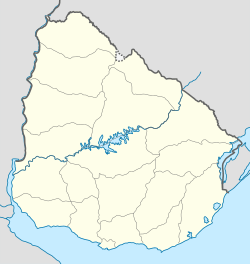San Jorge, Uruguay facts for kids
Quick facts for kids
San Jorge
|
|
|---|---|
|
Village
|
|
| Country | |
| Department | Durazno Department |
| Population
(2011)
|
|
| • Total | 502 |
| Time zone | UTC -3 |
| Dial plan | +598 436 (+5 digits) |
San Jorge is a small village in the Durazno Department of central Uruguay. It is a quiet place with a rich history. San Jorge is known for its connection to British settlers and its yearly festival.
Where is San Jorge?
San Jorge is located in the middle of Uruguay. It sits on Route 100. The village is about 76 kilometers (47 miles) northeast of the city of Durazno. Durazno is the capital city of the department.
A large artificial lake, Lago Rincón del Bonete, is about 13 kilometers (8 miles) north of San Jorge. There is also a stream called Arroyo Chileno about 13 kilometers to the east. This stream flows through a wide valley. Sometimes, this valley can flood when the lake's water level is high.
Because of the flooding, the road to the nearby town of Blanquillo is quite long. It stretches for about 56 kilometers (35 miles). The closest village to San Jorge is Aguas Buenas, which is 7 kilometers (4 miles) to the southeast.
San Jorge's History
San Jorge was started by British people in the 1800s. It was like a special British area. The estancia (a large ranch) called San Jorge became a center for new ideas. People there tried new ways of farming and industry.
For example, they put up fences to mark private land. They also planted many trees. They improved how they raised cattle. A mill was built to make flour. In 1897, people from San Jorge were the first British riders to play polo in Uruguay.
Since 2004, San Jorge has hosted a special event. It is called the Encuentro Británico-Oriental. This is an annual festival. It includes a parade and horseback riding contests. There is also music and stands selling handmade items. Visitors can also take a tour to see historical places.
How Many People Live Here?
In 2011, San Jorge had a population of 502 people.
See also
 In Spanish: San Jorge (Uruguay) para niños
In Spanish: San Jorge (Uruguay) para niños


